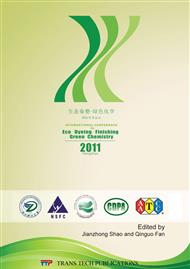p.150
p.155
p.160
p.165
p.169
p.174
p.179
p.183
p.187
Effects of Polar Solvent on the Structure and Properties of M-Aramid Fibers
Abstract:
The effects of polar solvent on the surface morphology, glass transition temperature, crystalline structure, dimensional changes and dye uptakes of m-aramid fibers were characterized by SEM, DSC, XRD, FTIR and dyeing process after dimethyl sulfoxide (DMSO) solvent treatment under different conditions. After DMSO solvent treatment, the surface of the fiber is roughened, the diameter of the fiber increases, and the specific surface area is increased. The crystallite size shows a little increase, but the glass transition temperature of the fiber drops sharply. Electron diffraction shows that effects of DMSO on the fiber structure is non-uniform, and the obvious structural changes lie on the outer surface of the fiber. Dye uptake increase has been achieved through the DMSO induced structural changes. The results have been used to improve the dyeability of meta-aramid fiber.
Info:
Periodical:
Pages:
169-173
Citation:
Online since:
January 2012
Authors:
Keywords:
Price:
Сopyright:
© 2012 Trans Tech Publications Ltd. All Rights Reserved
Share:
Citation:


